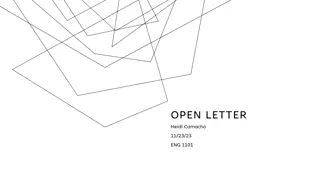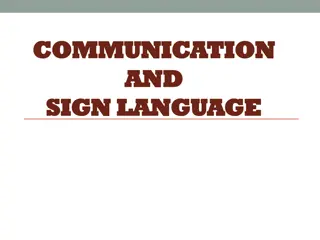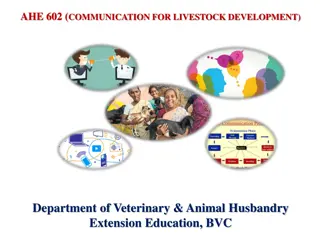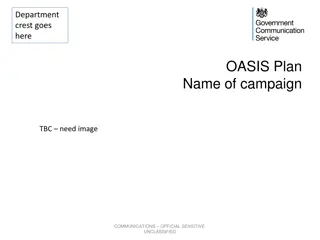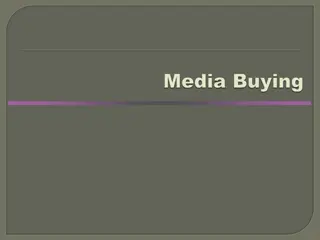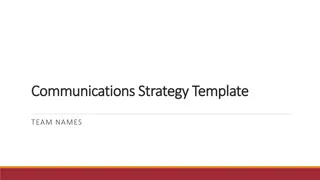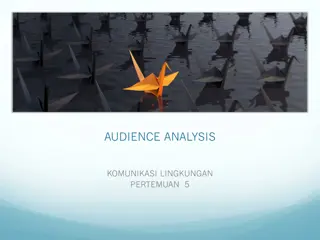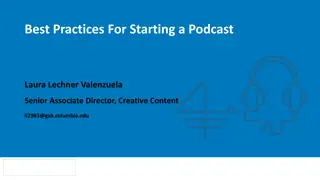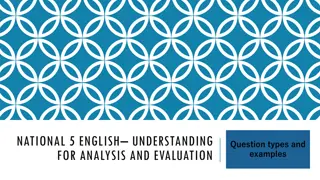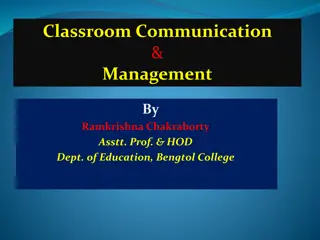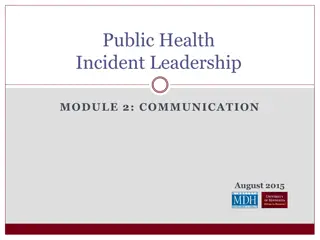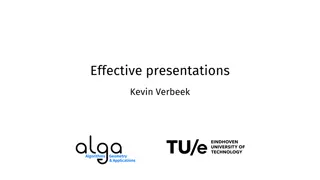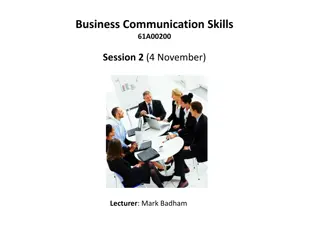Effective Audience Analysis for Successful Communication
Understanding the target audience is crucial for effective communication. This involves analyzing who the audience is, why it is important to communicate with them, and how messages can be tailored to meet their specific needs. By identifying parameters, customization strategies, and desired reactions, communicators can ensure their message is well-received and understood. Basic divisions in the audience, such as non-governmental and governmental organizations, internal and external stakeholders, employees, community groups, associations, and donors, further guide communicators in crafting tailored messages for different groups.
Download Presentation

Please find below an Image/Link to download the presentation.
The content on the website is provided AS IS for your information and personal use only. It may not be sold, licensed, or shared on other websites without obtaining consent from the author.If you encounter any issues during the download, it is possible that the publisher has removed the file from their server.
You are allowed to download the files provided on this website for personal or commercial use, subject to the condition that they are used lawfully. All files are the property of their respective owners.
The content on the website is provided AS IS for your information and personal use only. It may not be sold, licensed, or shared on other websites without obtaining consent from the author.
E N D
Presentation Transcript
AUDIENCE ANALYSIS KOMUNIKASI LINGKUNGAN PERTEMUAN 5
WHOS THE TARGET? A target audience is any group for which a message is specifically developed and intentionally focused. An intended audience is one that communicator expects to react to message.
WHY ANALYZING? Correctly analizing your audiences is one major way of overcoming barriers to communication and ensuring that your message gets through.
PARAMETERS OF ANALYZING What is the message? Why send it?
Who is (are) the audience (s) that need to be addressed?
Why communicate with them? What makes them important to the success of your campaign?
What makes them special and how you can customize your messages to meet their needs?
What do you want them to do with this information? What kind of reaction do you expect?
How will you know that they understood your message?
What was their reaction to your message?
Basic divisions in audience: Non-Governmental organizations INTERNAL EXTERNAL Full time employees Community groups Civic associations Consumers Recreationists Business community Seasonal staff Retirees Volunteers Members Board of Directors Corporate donors
Basic divisions in audience: Governmental organizations INTERNAL EXTERNAL Full time employees Seasonal staff Retirees Volunteers Contractors Advisory boards Legislators Visitors Neighboring Communities Special interest groups Business community Non-elected leaders
POPULATION SEGMENTATION Adoptions of New Ideas Laggards 16% Innovator s 2,5% Late Majority 34% Early Adopters 13,5% Early Majority 34%
TYPE CHARACTERISTIC Innovators - Pelopor, trendsetter, influencer - Often wealthy and socially established - Information seeker Early Adopters - Ready to try new things - Formal & informal leader of organizations with social influence. - Trendsetter & recommenders Early Majority -deliberate in their decision making about new ideas & trends. - Information source: family, friends, mass media Late majority A skeptical group, conservative lifestyle, getting information from friends, familly, rather than mass media Laggards Traditional. They adopt ideas reluctantly and only after they unable to avoid change.
POPULATION SEGMENTATION Support of Pro-environmental Issues Basic Browns 28% True-Blue Greens 11% Grousers 24% Greenback- Greens 11% Sprouts 26%
TYPE CHARACTERISTIC True_Blue Greens Mirip innovator, biasanya kaum mapan, sejahtera, berpendidikan tinggi, berpengaruh di masyarakat. Peduli pada lingkungan dan konsisten dalam perilakunya terhadap lingkungan. Mapan, sejahtera, berpendidikan tinggi, peduli pada lingkungan, namun kepeduliannya ditunjukkan lewat dukungan dana. Atau membeli produk-produk yang bersahabat dengan lingkungan. Biasanya tidak terlibat dalam aktivitas lingkungan. Kelompok mengambang (swing group). Bisa pro atau anti pada isu lingkungan tertentu. Biasanya berasal dari kelas menengah dalam pendidikan dan ekonomiTingkat pendidikan dan ekonomi menengah. Umumnya anti lingkungan. Berasal dari ekonomi dan pendidikan rendah. Selalu punya alasan untuk tidak peduli lingkungan. Greenback-Greens Sprouts Grousers Basic Browns Berasal dari kelas bawah, ekonomi dan pendidikan rendah. Anti lingkungan.
The Adoption Sequence Adoption: Idea adopted Trial: Starting to try the idea. Perlu dukungan dari sekitar Masih bisa berubah karena itu pesan secara periodik tetap perlu disampaikan Evaluation: To change from knowledge transmission to persuasion Perlu influencer/opinion leader Interest: How the idea affects audience Media massa masih sangat berperan Awareness: Exposing Idea Media massa berperan penting Richard Jurin, 2010
Internal factors that influence people to accept the idea Beliefs (keyakinan) What we think about other people, objects, places and issues. Communication that directly attack one s belief system will almost be ignored or worse, interpreted as threatening. Values (nilai-nilai) Value is a personal benchmark of what is desirable.They depend on beliefs and are more directly responsible guiding everyday behavior. Attitudes (sikap) Attitudes are focused and enduring mental organizations of information, based on several beliefs and values. Worldviews How we see the world: Beliefs+values+attitudes Opinions The verbal evidence of an individual s worldview SITUATIONAL FACTOR: NOISE Gangguan dari luar, misal bencana, kejadian tak terduga
Contoh Belief: Janganlah kamu berlebih-lebihan. Values: less is more, hidup sederhana, serakah itu tidak baik, berbagi itu indah. Attitude: Makanlah dengan bijak Worldwiew: Prihatin dengan masalah kelaparan Opini: Membuang-buang makanan itu adalah tindakan yang tidak baik.






